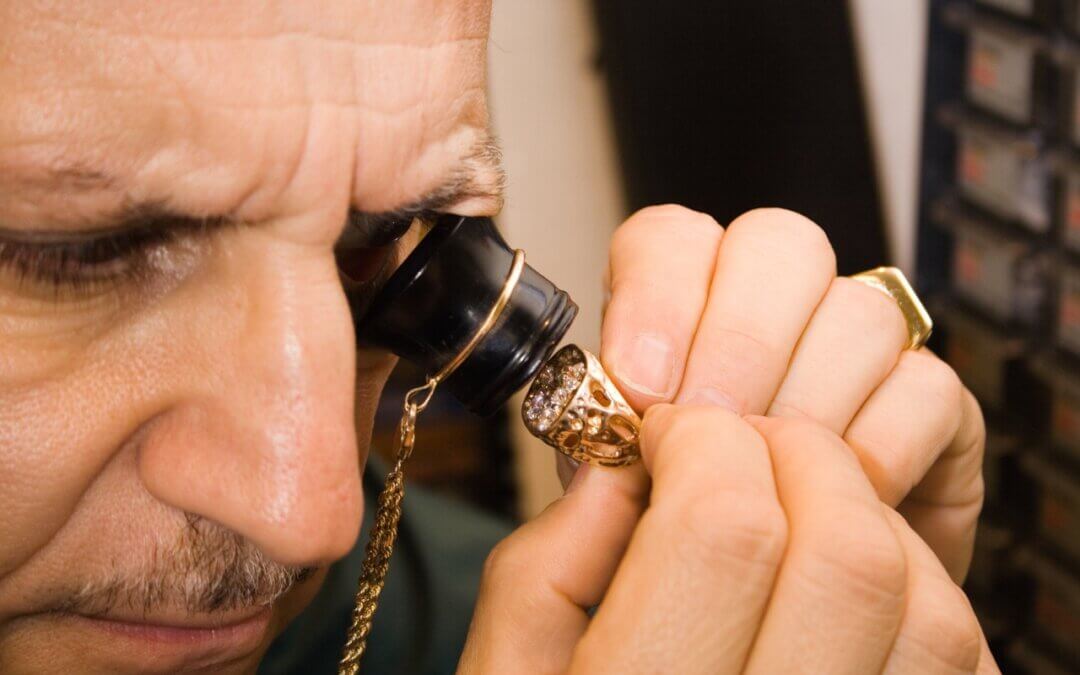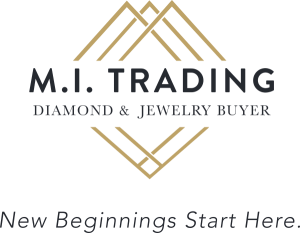The Basics of Gold Jewelry Purity and Quality
When selling gold jewelry, understanding the concepts of gold purity and quality is essential to ensuring you receive a fair price. These factors are crucial for evaluating the actual worth of your items, whether it’s a necklace, ring, bracelet, or earring. Our goal is to equip you with the knowledge needed to appraise your quality jewelry effectively, empowering you to make informed decisions in the gold market.
What Does Gold Purity Mean and Why Is It Important?
Gold purity refers to the amount of pure gold in a piece of jewelry compared to other alloyed metals. For instance, solid 14k gold combines gold with other metals for durability, making it ideal for fine jewelry that’s both versatile and timeless. Pure 24-karat gold is too soft for everyday wear, so it is mixed with metals to enhance its strength. The purity of your gold jewelry, whether it’s solid gold or alloyed, significantly affects its value. Higher purity means higher worth, making this knowledge essential when assessing traditional or modern pieces alike.
Common Measures of Gold Purity
The karat system is the most common measure of gold purity, ranging from 1 to 24 karats (k), with 24k representing pure gold. For example:
- Solid 14k gold: Contains 58.3% pure gold, making it durable and suitable for everyday wear.
- 18k gold: Composed of 75% pure gold, often used for high-quality jewelry and exquisite designs.
- 10k gold: Contains 41.7% pure gold, offering affordability and durability.
In addition to karat ratings, you’ll often find hallmarks or fineness stamps (e.g., 750 for 18k gold) indicating the parts per thousand of pure gold in a piece. Recognizing these marks on your chain, cuff, or charm can enhance your understanding of its value.
The Relevance of Gold Purity to the Value of Gold Jewelry
The purity of gold directly impacts the market value of your gold jewelry. For instance, an 18k yellow gold necklace or solid 14k gold bracelet will generally be more valuable than pieces with lower gold content. However, other factors like craftsmanship, durability, and style also influence the price.
For example:
- Timeless designs like stud earrings or chains often hold their value over time.
- Thicker pieces, such as bold cuffs or chunky bracelets, may fetch higher prices due to their weight.
- Thin and delicate fine jewelry items may appeal to buyers seeking pretty and versatile accessories.
Understanding how purity and other attributes, like being nickel-free, contribute to your jewelry’s worth is key to setting realistic expectations.
How To Identify Gold Purity Marks on Your Jewelry
Recognizing purity marks on your jewelry is a critical step in determining its value. Hallmarks, typically found on the inner part of a ring or the clasp of a necklace, indicate the gold content, such as:
- 10k: 41.7% gold
- 14k: 58.3% gold (solid 14k gold)
- 18k: 75% gold
- 24k: Pure gold
Some hallmarks also identify the manufacturer or country of origin, providing additional insight into the piece’s history and craftsmanship. For example, a solid 14k yellow gold necklace with a hallmark stamp not only indicates the gold purity but also assures buyers of its authenticity and exquisite craftsmanship.
The Role of Appraisals in Gold Selling
Professional appraisals are vital when selling specialty jewelry, such as antique bracelets or fine necklaces. An appraisal evaluates not just the gold content but also factors like style, historical significance, and market demand.
Solid gold rings with intricate designs or charms with distinctive craftsmanship often warrant higher appraisals.
Appraisals also provide documentation for insurance purposes and ensure you achieve the best price for your quality jewelry.
When selecting an appraiser, choose one certified by recognized institutions, such as the American Society of Appraisers. A professional will evaluate your jewelry’s durability, beauty, and overall condition, offering a complete and accurate valuation.
Making Informed Decisions
Whether you’re selling a traditional yellow gold bracelet, a modern ring, or timeless stud earrings, understanding gold purity and quality ensures you can confidently navigate the gold market. By familiarizing yourself with purity marks, working with professionals, and appreciating the versatile style and exquisite craftsmanship of your items, you can secure the best value for your fine jewelry.
Understanding the Market Value of Gold Jewelry
Gold prices fluctuate based on economic indicators, currency values, and global demand. For owners of gold jewelry, understanding how these factors influence the market is essential when deciding whether to sell or keep their piece of jewelry. By monitoring trends, tracking daily price shifts, and understanding the economic backdrop behind these changes, you can make informed decisions about your collection.
Incorporating this knowledge allows you to better gauge when your item might fetch the highest selling price. While the intrinsic value of gold remains constant, market prices significantly impact what buyers are willing to pay. Use tools and resources offering real-time gold prices and market analysis to stay informed and maximize your returns during a sale.
Tips for Selling Your Gold Jewelry
When it’s time to part ways with your piece of jewelry, whether for financial reasons or decluttering purposes, knowing how to proceed ensures a smooth and rewarding experience. Following these steps will help you maximize the value of your products while ensuring safety and fairness.
Preparing Your Gold Jewelry for Sale
Preparation is key when selling your gold jewelry. Clean your item gently to enhance its appearance and create a great first impression. Avoid harsh chemicals that may harm the material or any diamonds and gemstones included in the design.
Gather documentation such as original receipts, certificates, or appraisals, especially for high-value pieces with gemstones or from recognized brands. These can build buyer confidence and potentially increase the selling price. Presenting your piece in its original box, if available, can also make it more appealing
Choosing Between Different Selling Options
Selling gold jewelry is not a one-size-fits-all process. You have multiple avenues to consider, each offering distinct benefits:
- Jewelry Stores: Local stores often buy back pieces from customers. Selling to a trusted shop allows you to deal face-to-face with professionals, offering a sense of security and immediacy.
- Online Marketplaces: Platforms like eBay or Etsy provide access to a wider audience. High-quality photos and detailed descriptions of your product are essential to attract buyers.
- Pawnshops: If you need quick cash, pawnshops are a viable option. However, their focus on resale may result in lower offers compared to other methods.
- Local Jewelry Buyers: Specialists in pre-owned jewelry collections, these buyers may offer higher prices and can accommodate your preferred meeting location.
Selling Through M.I. Trading
For those looking for a highly reputable brand, M.I. Trading is a standout option for selling gold jewelry. We specialize in pre-owned collections, understanding both the intrinsic and sentimental value of your items. Unlike generic buyers, we ensure your piece is valued based on its material, design, and additional features such as diamonds and gemstones.
Our transparent evaluation process, conducted by experienced valuators, ensures you’re treated as a valued client rather than just part of a transaction. Trusting your collection with M.I. Trading means selecting professionalism, expertise, and a personal touch.
Negotiating the Best Deal
Negotiation is a vital part of selling valuable products like gold jewelry. To ensure safety and fairness:
- Meet in secure public spaces for face-to-face transactions.
- For online sales, use reputable platforms with secure payment options.
- Take your time to evaluate offers—don’t rush into a deal. If an offer feels too low, it’s okay to explore other options.
Having knowledge of the current market price for gold and its effect on your item gives you a stronger position during negotiations.
Common Mistakes to Avoid When Selling Gold Jewelry
Entering the gold-selling market without preparation can lead to costly mistakes.
- Accepting the First Offer: It’s wise to explore multiple buyers and compare offers before finalizing a deal. The first offer isn’t always the best.
- Not Verifying the Buyer’s Credibility: Always research the background of the buyer, whether online or in person. Check reviews, ratings, and feedback to ensure they meet industry standards.
- Overlooking Sentimental Value: While financial worth is important, don’t disregard the emotional attachment to your piece. Be sure you’re ready to part with your jewelry collection before proceeding with the sale.
Are you sitting on a gold mine? Your jewelry box might hold more value than you realize. The shifting tides of the gold market potentially turn your unworn pieces into substantial gains.
Delve into the fascinating world of gold trading, where your jewelry’s hidden worth can be unveiled. Imagine converting those forgotten treasures into a financial boost or an opportunity to upgrade your collection.
Picture yourself leveraging the current market highs, trading in your gold for something valuable, or simply enjoying the monetary gains. With M.I. Trading, experience a seamless, respectful selling process that appreciates the true worth of your precious items.



Recent Comments